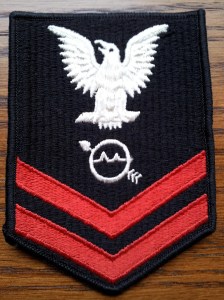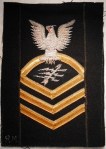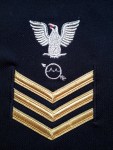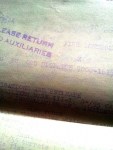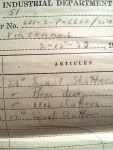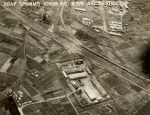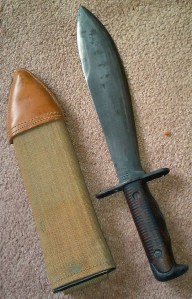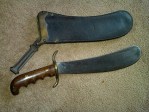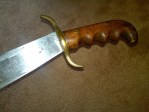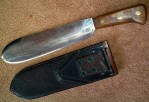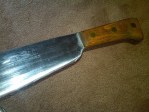Category Archives: World War II
Subtle History – Finding a Unique Naval Militaria Piece
Remaining focused with collecting can be a challenge, especially when it comes to militaria. If you are a die-hard fan of military history, it becomes quite difficult to keep composed when unique pieces of history become available. However, when one of those unique items surface that actually does directly tie-in to one’s principal areas of collecting, it cannot be passed up.
During the first four of my ten years of naval service, I was blessed to be assigned to the pre-commissioning crew of the U.S. Navy’s newest (at that time) cruiser – the first to be assigned to the Pacific Fleet – the USS Vincennes. My assignment was handed to me as I was graduating from my naval training school and, at that time, I had no idea of the history of the name of that ship. It was a name that I struggled to pronounce correctly.
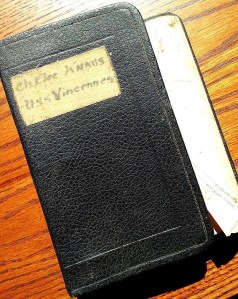
This binder is labeled with the name of the owner (Chief Electrician Knaus) for the USS Vincennes. It was used during the ship’s overhaul in 1939. I still need to research Chief Knaus to see if I can locate any details of his service.
Upon reporting in to the command located in San Diego, where the ship was to be homeported upon completion, I was quickly immersed into the history of the ship’s name and bowled over by the sheer excitement and passion for the legacy of the citizens of the Indiana city from where the ship drew her name. I was also immediately connected to a 500-member-strong group of World War II veterans (who had served aboard either of the two WWI cruisers that also bore the name), all of which had incredible pride for this ship. These men and their wives had played a significant role in convincing the navy leadership to name the third ship of the Ticonderoga class cruisers to honor three previous front-line navy warships that had also carried the name Vincennes.
Since the mid-1980s, I’ve been immensely interested in anything pertaining to the three previous USS Vincennes warships. I’ve collected press photos, news articles, first day postal covers and other ephemera that are somehow connected to the ships. Seldom have I seen items with more direct significance than something that actually came from the ships as preserving the history during their service was neither a thought, or in the case of the CA-44 – which was sunk by the Japanese at Savo Island on August 9, 1942— possible. A few months ago, an interesting piece surfaced that had historical significance and direct ties to the CA-44. More than likely, it was aboard the ship as part of a daily routine. While it isn’t anything that is correlated to a battle or naval engagement, the importance of this piece did provide some ancillary historical details regarding the configuration changes made to the weapons and other shipboard systems.
- This work order specifies changes made to the 5″ – 25 caliber anti-aircraft guns’ electrical system.
- The Vincennes’ main battery was comprised of three triple turrets, each with 8″ – 55 caliber guns. This work order details changes to the emergency hatches.
- This slip documents changes to the ship’s signal lights – the tools of the trade for the signalmen.
Listed on an online auction site was, at least for me, was the holy grail. It is a binder containing work orders for electrical jobs during an overhaul period in 1939. Contained within are forms and handwritten work orders specifying upgrades and configuration changes made to the ships electrical systems. Some work orders detail modernization of weapons systems that would meet the changes to the geopolitical landscape and the escalation of war in Europe and Asia.
I was fortunate that my bid was high enough to beat out others but was still in line with my budgetary limitations.
The binder provides me with a fantastic vantage point as I continue to document the history of these great warships and is a great addition to my tiny Vincennes collection.
Bataan/Corregidor POWs – Looking Back 75 Years
Five months. Depending upon your perspective, this span of time may seem to be a brief moment or a lifetime. If you are anticipating a well-planned vacation, you count the days down with excitement. If you are completing a career and your retirement date is approaching, you might have some anxiety about the significant change in life that you are facing. For the men on Corregidor in May of 1942, it was the culmination of a long-fought battle that was about to come to an end.
The Japanese had planned simultaneous, coordinated attacks on United States military bases in an effort to subjugate American resistance to their dominance in the Western Pacific. Seeking to seize control of natural resources throughout Asia and the South Pacific, the Empire of Japan had already been marching through China, and having invaded Manchuria in 1931, they continued with full-scale war in 1937 as they took Shanghai and Nanking, killing countless thousands during the initial days of hostilities. American sanctions and military forces, although not actively engaged, stood firmly in the Japanese path of dominance.
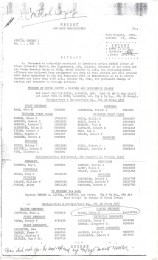
A copy of the transfer orders for the 5th Air Base Group, October 1941. My uncle’s father is listed here along with one other veteran who was with him throughout his entire stay as a guest of the Empire of Japan.
The father of my uncle (by marriage), enlisted in the U.S. Army Air Corps in 1941 and was assigned to the Decontamination Unit of the 4th Chemical Company, one of 204 members of the 5th Air Base Group that had been transferred to the in Far East Air Force in the Philippines in late October. Like many other new privates, this man had enlisted to escape the tight grip of the Great Depression and massive unemployment, seeking steady pay while embracing a new life of service to his country. The Philippine Islands, though remote and thousands of miles away from the comforts of home, represented a certain measure of adventure. He was unaware what the next four years would bring.
On December 8, 1942, Japanese forces landed on Luzon in the Philippines as they kicked off what would become a lengthy campaign in an effort to gain control of the strategic location and to remove the threat of any resistance of their ever-expanding empire by the forces of the United States. Grossly under-prepared for war, the 150,000 troops (a combination of American and Philippine forces) were plunged into battle, defending against the onslaught of the 130,000 well-seasoned, battle-hardened enemy forces.
The American forces were almost immediately cut off from the promised supplies and reinforcements that would never be sent.
- 20th Air Force B-29s lined up (on Saipan) for post-surrender POW supply drop.
- An aerial photo (taken by 20th Air Force personnel) of one of the POW camps at Fukuoka.
- As they prepared to resupply them after the surrender of Japan, the 20th Air Force photographed and documented the locations of POW camps throughout Japan.
Over the course of the next five months, U.S. and Philippine forces fought a losing battle in an almost constant state of retreat as supplies wore thin and troops wore out. Exhausted, beat-up and starving, the defenders (of the Bataan Peninsula and Corregidor) were done. Having suffered considerable losses (25,000 killed and 21,000 wounded), General Jonathan Mayhew Wainwright indicated surrender by lowering the Stars and Stripes and raising the white flag of surrender. More than 100,000 troops were now prisoners of war in the custody of the Imperial Japanese forces and would endure some of the most inhumane and brutal treatment every foisted upon POWs. My uncle’s father, a young private was now among the captured, on the march to an uncertain future.

An engraved mess kit from a Bataan veteran (photo source: Corregidor – Then and Now).
The five months of uncertainty and hopelessness that my uncle’s father experienced as a Bataan Defender since hostilities began would become years of daily struggles to survive in prison camps where beatings, starvation and executions were the new normal.

A POW letter to loved ones providing basic information of internment (photo source: Corregidor – Then and Now).
To say that Prisoner of War artifacts are a rarity is a gross understatement. POWs (captives of the Japanese) had to scrounge, steal and beg for basic necessities. Any personal possessions they might have had during the 80-mile forced march were taken once they arrived at makeshift camps. Those few captives who were crafty would manage to conceal small mementos, avoiding detection by the prison guards.
Aside from personal accounts of the atrocities that were told by liberated prisoners after the war, documentation proved helpful in war crime trials of the Japanese camp administrators. Prisoners ferreted away scarce paper and documented brutal acts and names of POWs who were killed or died of disease and starvation. Any of the items that were brought home by these men have tremendous significance as historical records and possess value well beyond a price tag.
May 6, 2017 marks the 75th anniversary of the surrender that launched a painful chapter in my uncle’s father’s life that remained with him for the rest of his years. Through my research, I have been able to determine that he was a POW at the Davao Penal Colony until it was closed in August of 1944. By the war’s end, he had been moved to Nagoya #5-B having made the trip to Japan aboard one of the infamous Hell Ships.
He never really talked about his experiences (at least with me). This man chose instead to let the past remain in its proper place. Unfortunately, I don’t know what might have become of any items he may have returned home with. My hope is that if they do exist, his POW artifacts are with his children or grandchildren, preserved in hopes that his experiences are not forgotten.
Bataan Prisoners of War References:
A Bullet with No Name
Most people who know me would agree with the statement that I take pleasure in the obscurity and oddities in life. If there is any sort military or historic significance, my interest is only fueled further.
Militaria collectors have heard the same story told countless times by baffled and befuddled surviving family members – the lost history of an object that (obviously) held such considerable personal significance that a veteran would be compelled to keep the item in their inventory for decades. For one of my veteran relatives, that same story has played out with an item that was in among the decorations, insignia and other personal militaria, preserved for fifty-plus years.
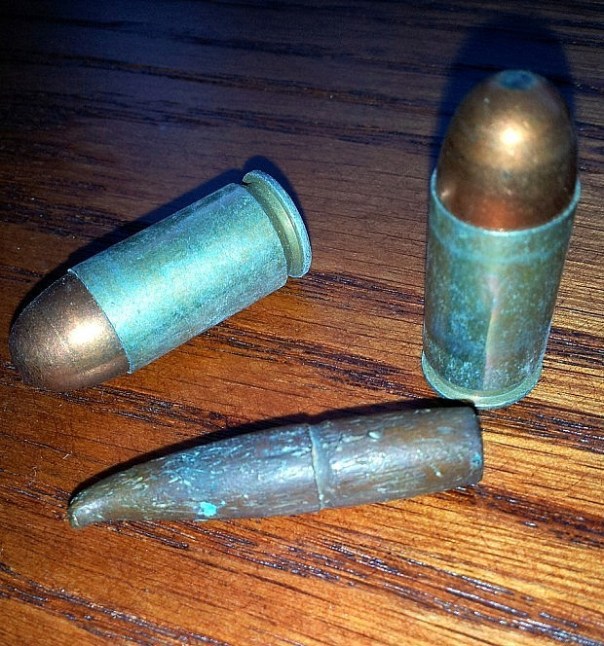
The crimp ring around the middle of the bullet’s length shows where the top of the bullet casing was pressed against the projectile. When compared to these WWII .45cal rounds, it becomes apparent that the bullet is in the 7mm bore size-range.
When I received the box of items, I quickly inventoried each ribbon, uniform button, hat device and accouterments that dated from his World War I service through the Korean War. The one item that caught me by surprise was a long, slender lead projectile with a mushed tip.
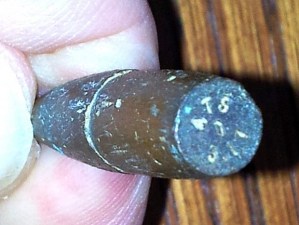
They are difficult to make out with the naked eye, but the markings are “A-T-S” and “L-V-C”. The character in the center doesn’t appear to be a character at all.
It was clear that this blackened item was a small arms projectile. Based on size comparison with 9mm and 7.62 rounds, it was more along the lines of the latter, but it was clearly not a modern AK/SKS (or other Soviet-derivative). Perhaps it was a 7mm or smaller round? Without any means to accurately measure the bullet, I cannot accurately determine the bore-size or caliber. I’ll have to leave that for another day.
Further examination of the object proved to me that it was bullet that had been fired and had struck its target, causing the tip to blunt. While I am not a ballistics expert, I have seen the markings that firing makes on a bullet. This round clearly has striations that lead me to believe that it has traveled the length of a rifled barrel. It also possesses a crimping imprint, almost at the halfway-point on the projectile.
So what does all this information mean? Why did my uncle hang on to it for all those years? Had this been a bullet that struck him on the battlefield? Had it been a near miss?
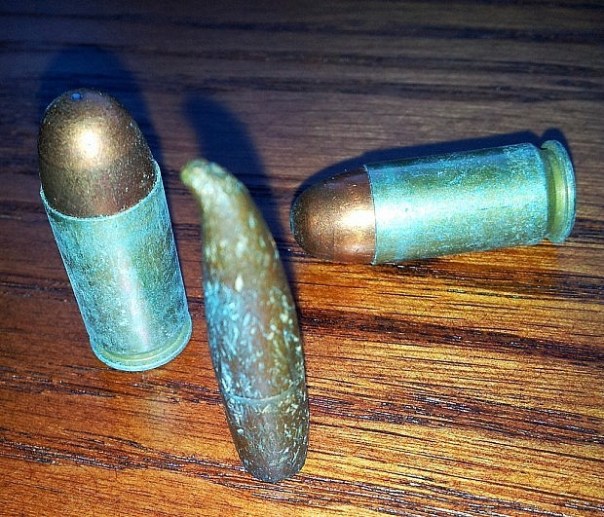
In this view, the mushed tip is easily seen, as are some of the striations.
My uncle passed away 20 years ago and the story surrounding the bullet sadly died with him. Since he bothered to keep it, so will I along with other pieces in a display that honors several of my family members’ service.
Combat Medical Blades – Bolo Knives

Indiana Jones faces off with a sword-wielding opponent on the streets of Cairo in Raiders of the Lost Ark (source: Paramount Home Entertainment (Firm). (2008). Raiders of the lost ark. Hollywood, Calif: Paramount Home Entertainment).
When confronted by a henchman in a scene from the film, Raiders of the Lost Ark, Indiana Jones (played by Harrison Ford) notices the fancy blade-wielding skills of his opponent. Unimpressed by the acrobatics and the fancy blade-twirling bad-guy, Indy retrieves his revolver from his holster firing a single, well-placed shot, dropping the adversary nonchalantly.
I don’t profess to have knowledge of the type of sword wielded by unimportant character in that film nor do I have expert knowledge in the field of military edged weaponry. What I do have in my scabbard is the ability to use the research tools at my disposal – which comes in quite handy when given an arsenal of knives, swords, bayonets and bolo knives.
A few years ago, I was asked to catalog and obtain value estimates of some militaria pieces that were part of a family member’s collection. He had passed away some time before and his executor was carrying out the responsibilities of handling the estate. In the previous years, I had only seen a few items from the collection so I was surprised when I saw what was there for me to review. After completing my work on behalf of the state, I later learned that I was to receive some of the pieces that I had appraised, much to my surprise.
Of the blades I had inherited, three were quite unique, different from the rest of the pieces. Two of the three blades were almost identical in form and the other was a slight departure from the others. What set these blades apart from the rest was machete-like design with more size toward the end of the blade, giving the blade a bit of weight toward the end of the blade rather than at the center or toward the hilt. The design of these blades were fashioned after the weapon of choice of the Filipino resistance fighters from the revolt that started at the end of the Spanish-American war in 1898.
Known simply as bolo knives, the U.S. military-issue blades were less weapon and more utilitarian in function.
- The unique brass belt hanger of the leather-clad scabbard is much different from most WWI web gear attachments.
- The M1904 hospital corps bolo with its unique s-shaped brass hilt.
Now in my collection, the oldest of the three knives is the M1904 Hospital Corps Knife. Though many people suspect that the broad and heavy blade was important to facilitate field amputations, this thought is merely lore. Along with the knife is a bulky, leather-clad scabbard with a heavy brass swiveling brass belt hanger. My particular example is stamped with the date, “1914” which is much later in the production run. The M1904 knives were issued to field medical soldiers as the United States entered World War I in 1917.
The second knife is less bolo and more machete in its design. The M1910 bolo was designed and implemented for use as a brush-clearing tool. Some collectors reference the M1910 as a machine-gunner’s bolo as it was employed by the gun crews and used to clear machine gun nests of foliage and underbrush. My M1910 bolo is date-stamped 1917 and includes the correct leather-tipped, canvas-covered wooden scabbard.
- This 1944-dated USMC bolo and scabbard are a cherished part of my collection.
- The blade and hilt of the USMC World War II bolo.
The last bolo in my collection is probably the most sought-after of the three examples. Stamped U.S.M.C. directly on the blade, these knives were issued to U.S. Navy pharmacist’s mates who were attached to U.S. Marine Corps units. This detail leads many collectors to improperly conclude that the markings on the blade clearly indicate that the knives were made for the Marines. While this is indirectly true, the U.S.M.C. markings represent the United States Medical Corps, a branch of the U.S. Navy. On the reverse side, the blade is date-stamped, “1944” making the blade clearly a World War II-issued knife.
Although the blades are relatively inexpensive, they are considerably valuable to me as they come from a family member’s collection and were handed down to me. Though I do not have a desire to delve too far into edged weapons-collecting, I added to my collection by acquiring a pair of US Navy fighting knives to round out my collection. In future posts, I will cover these two types of knives, swords and sabers and even a few bayonets.
